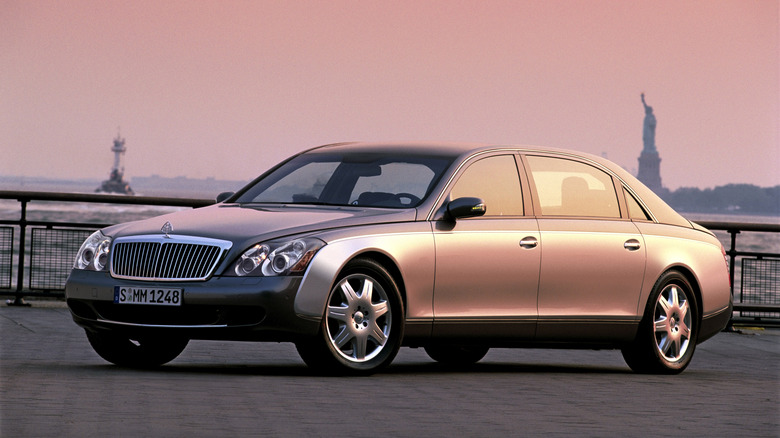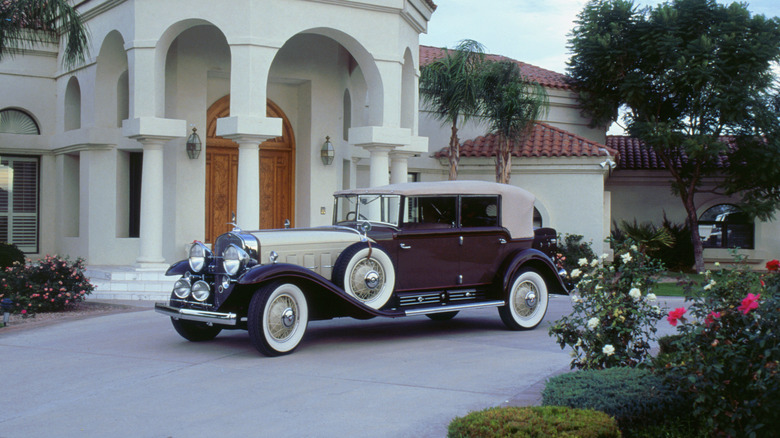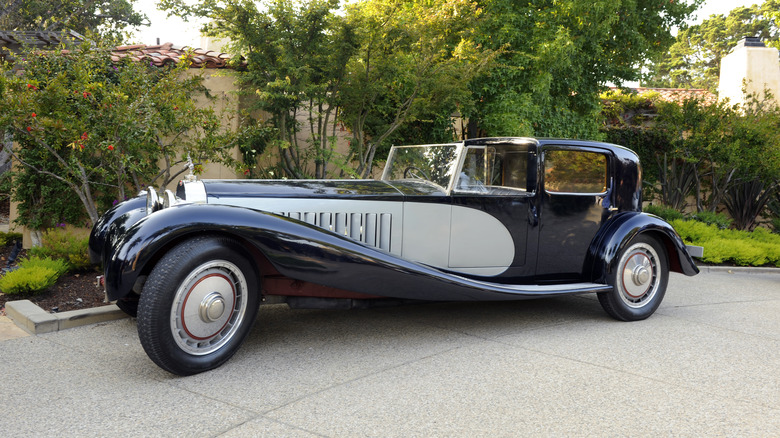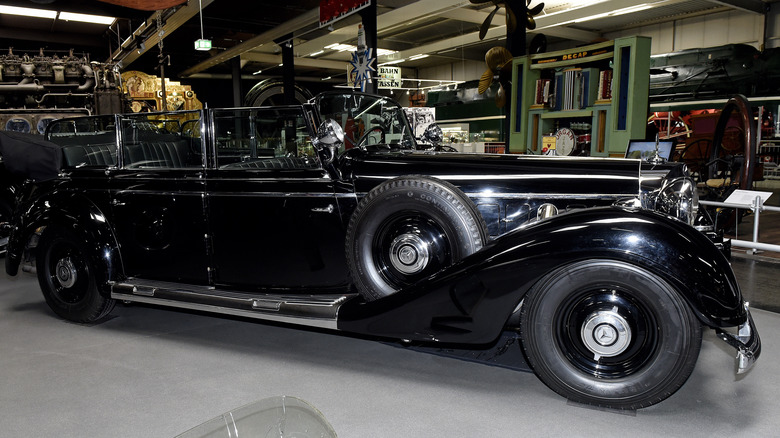5 Of The Heaviest Cars To Ever Hit The Road
In America, too big is not big enough. We like bigger paychecks, bigger houses, and, yes ... bigger cars. While bigger doesn't always equate to heavier, in this case, it does.
Some caveats: we're limiting this list to only cars. Not trucks, vans, or SUVs. For instance, an International CXT weighs 14,500 pounds, four thousand pounds more than the heaviest car on our list. A mass-produced GMC Hummer weighs a skoosh over 9,000 pounds, and even a commonplace Ford F450 Super Duty Crew Cab has a curb weight of 8,600 pounds.
Since we're only listing cars, not trucks, we'll use curb weight instead of gross vehicle weight. Curb weight refers to the car sitting at the curb with standard equipment, a tank full of gas, and no passengers/cargo. Gross vehicle weight includes the extra weight of passengers and cargo.
Furthermore, as long as the auto manufacturer made at least one of the said vehicles that was neither special nor custom ordered, with the intent of selling it to whoever could afford it across any decade — it's fair game.
Mercedes-Maybach 62
According to a 2020 report from the Environmental Protection Agency (EPA), the average weight of a car is around 4,156 pounds. The first car on our list sits more than 2,000 pounds above that. At 6,294 lbs, we have the Mercedes-Maybach 62, a vehicle designed to be the ultimate luxury car.
First built in 2003 (and lasting until 2012), Mercedes introduced models 57 and 62 in the same year. The 57 was the smaller, "cheaper" version, while the 62 was meant to be driven by an actual chauffeur. At 20.23 feet (242.72 inches) a 5.5L V12 powered the 62, and the "S" variant had a 6.0-liter twin-turbo V12 with twin liquid-to-air intercooled turbochargers.
The size, weight, and other specs/dimensions varied based on the model year features and equipment packages. For instance, an array of other high-end features like a 21-speaker Bose system, electrohydraulic 8-circuit braking system, massaging seats, and rear center console refrigerator added to the overall girth of this car. Plus, an available non-smoker package swapped out the ashtrays for storage compartments.
The goal was to go head to head with luxury car makers, but poor sales put an end to the 62.
Cadillac V-16
The Cadillac V16 was built between 1930 and 1940, with a price tag starting at $ 5,350 and going to $9,700. This car dropped amidst the Great Depression when a new Ford cost less than $500, and money was tight. This luxurious car was never meant to be driven by most people.
Fifty-four "semi-custom" body styles were offered to the public, from sports models to open-air phaetons and fully decked limousines. Variations were often so minute it was hard to tell them apart. The curb weight varied (sometimes only slightly) based on the year, make, and model, with many hovering well north of 6,000 pounds.
However, the heftiest of these was 1934 (with modified V-windshield) and 1935 Town Cabriolet (with V-windshield), both of which tipped the scales at 6,390 pounds and had a body length of 20 feet (240 inches). By comparison, the average length of a modern car is 14.7 feet, while a pickup truck averages 19.8 feet.
As the name implies, this line of Caddys came with a 452 cubic inch, 16-valve engine comprised of two V8s bolted to an aluminum-alloy crankcase and produced 175 horsepower. According to sources, sales weren't great — probably because of the timing of its release (the Great Depression lasted from 1929-1939, almost its entire production run). In fact, it's believed that Cadillac lost money on every V16 it built over its ten-year span.
Bugatti Type 41 Royale Kellner
Bugatti made its Type 41 Royale Kellner between 1927 and 1933, again during the Great Depression. And although it looks similar to Cadillac's V16, it's very different. First, only six total were made (two of which never sold), and has been referred to not only as one of the world's rarest cars but as "the most expensive" because back in 1987, one sold for $9.7 million.
Before working on the Royale in 1927, company founder Ettore Bugatti had designed a 14.7-liter 300-hp aircraft engine for the French government. He started with that as the basis for the Royale's engine and eventually scaled it down to a 12.8-liter inline V8 with the same horsepower.
Depending on the custom-made body, the car could have a curb weight of as much as 3.5 tons (7,000 pounds). That wasn't the only big (or heavy) thing about the Royale. It used a unique dry sump system to move 23 liters (six gallons) of lubricant through the car and 43 liters (11.4 gallons) of cooling oil to keep things from overheating. The engine was so long it required a lengthy hood cover that took two people to open correctly. Additionally, the gas tank held an astounding 200 liters (52.8 gallons).
It cost ten times more expensive than any other Bugatti on the market and three times more than comparable limousines. As one might expect, this car was not a commercial success either, but Bugatti modified the V8 again and used them in express trains for the French state railway system.
Mercedes-Benz 770K Grosser Cabriolet
If you ask Google, you might see this Mercedes as the heaviest car ever. Those lists would be wrong. It's close but doesn't quite get it to the top. Still, it's quite an accomplishment for one automaker to make it twice on a list of heaviest cars ever made. So, how can one without a roof be all that heavy?
Well, Mercedes wanted to make sure its occupants were safe. Like "running over a bomb and living to tell the tale," safe. This car was used by none other than Adolph Hitler and Emperor Hirohito of Japan, both of World War II Axis infamy.
The floor sported mine-proof armor; the windowpanes were coated with several centimeters of bulletproof glass, and the doors were armor-plated. And if that weren't enough protection, a retractable armor plate sat behind the rear seats so the occupants wouldn't get shot in the back.
All this protection weighed a lot — roughly five tons. Estimates peg a curb weight of around 10,582 pounds. To move all that heft, Mercedes dropped a 7.6-liter supercharged in-line V8 producing 230 hp at 3200 rpm with a top speed of 87 mph.
ZIL-41047 TB limousine
Finally, we come to the ZIL-41047 limousine. Guinness World Records lists this as the heaviest car in the world. Since it was made in Russia, details are a bit sketchy, but according to sources a standard base model and a special armored version known as the ZiL-41047 TB were made. Guinness claims that two or three were produced annually, but another source says ZIL only made three total.
The standard version has a 12.72-foot wheelbase with a curb weight between 7,352 pounds and 7,496 pounds. This model alone would make it heavy enough to get it on the list. However, the other version was weighted down by protective armor (ala the MB 770K) as Russian heads of state (including President Mikhail Gorbachev) were known to utilize it.
In 1992, well-known German armored car builder Trasco Bremen fitted critical areas of the car with 75-millimeter (3-inch) armor-plated steel that added extra weight to the car. Guinness claims it weighed six tons (13,000 pounds), while another source shows it weighing 5,170 kg (11,398 pounds). Either weight puts it firmly at the top of the list. A 7.7-liter V8 producing 315 hp was available in the base version. These ZIL's fell out of fashion in Russia in the early 2000s as more modern vehicles were made available.




